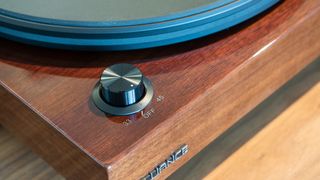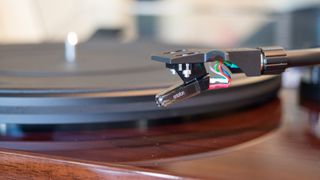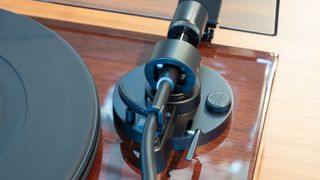TechRadar Verdict
The Fluance RT82 is a noticeable step up from the entry-level RT81. While the RT82 loses the built-in phono preamp, it’s the superior turntable in terms of sound quality, accuracy, and control. The RT82 is the turntable for those who want to take collecting vinyl seriously without breaking the bank.
Pros
- +
Excellent build quality for the price
- +
Good quality quality for the price
- +
Auto stop feature preserves the stylus
Cons
- -
No phono preamp
- -
Users need to pay attention to grounding
- -
Slightly too much bass
Why you can trust TechRadar
Fluance has solidified its reputation for making value-focused audio products and the Fluance RT82 turntable is no exception.
We said the Fluance RT81 was “easily the best starter turntable you can buy” and we stand by that. However, those who want a set up in sound quality will want to step up to the RT82 instead. While the RT82 ditches the onboard phono preamp, it makes up for it with a much better cartridge and motor.
Here's why it's one of the best turntables you can buy this year.
Price and availability
The Fluance RT82 is available for $299 / £299 (about AU$539) from various retailers around the world.
Design
The Fluance RT82 comes in three different finishes: bamboo, piano black, and natural walnut (as seen in this review). The turntable measures 5.5 x 16.5 x 13.75 inches / 14.0 x 41.9 x 34.9 cm (HxWxD).
The RT82 features a s-shaped tone arm and a lovely aluminum speed control knob, allowing you to select between 33 ⅓ and 45 RPM. It carries over the auto start/stop feature from the RT81, which helps preserve your stylus when you reach the end of a record.

The platter is made of aluminum and a flat belt connects it to the motor and a rubber mat is included in the box to top the platter.
Around the back are RCA outputs, a grounding post, a switch to toggle the auto stop feature, and a power port. The included power supply is a small wall-wart.
Holding everything up are three pointed rubber feet that are easily adjustable to help level the turntable. Fluance includes a small bubble level to help users dial in the turntable. It’s crucial to have the turntable be completely level, otherwise the platter will spin at different rates, altering the pitch.
Features
At first glance, the RT82 looks nearly identical to its baby brother, the RT81. However, you can tell the two apart by the motor and the included cartridge. The motor on the RT82 is far superior as it’s separated from the platter, helping with isolation from any unwanted motor hum. The included Ortofon OM 10 is also a big step up from the Audio-Technica AT95E from the RT81.
The motor is a notable upgrade from the RT81. The RT82’s motor is a direct current servo-controlled motor that is isolated from the platter to reduce unwanted motor hum. The platter and motor are joined by a flat rubber belt.

Like the RT81, the RT82 retains the auto start/stop feature, which can be disabled with a switch on the back of the turntable.
The biggest difference between the two siblings is the lack of the phono preamp on the RT82. While this seems counter intuitive (why would a more expensive turntable lack a built-in amp), it actually makes a lot of sense. The included phono preamp on the RT81 is average and excluding it redistributes the budget to include a better motor and cartridge on the RT82. Both these upgrades mean the sound quality is noticeably better.
The turntable includes a nice dust cover to protect the turntable, though Fluance recommends removing it altogether for the best sound and we agree.
Audio quality
While the RT81 with its Audio-Technica cartridge sounded good, the RT82 sounds noticeably better. There’s more detail, separation, and dynamics. For only $50 more than the RT81, the step up in sound quality is worth it, assuming you pair it with a good phono preamp. Our test rig paired the Fluance RT82 with the Vincent PHO-8 phono preamp feeding a pair of KEF LS50 Wireless speakers.
The overall sound quality of the Fluance RT82 is warmth. The included Ortofon OM 10 cartridge has bass in spades, which makes for a relaxed and fun sound. However, we wished the sound was slightly more neutral to work with more genres of music. The bass isn’t overwhelming but it did bleed into the mids at times, presenting some vocals as smeared. Highs lacked the extension of more expensive turntables and cartridges but that’s expected in this price range.

The consistency of speed was definitely noticeable, which we knocked the RT81 for. The upgraded motor does a good job of keeping pace, though we did find it hunting a bit on a few acoustic tracks.
Isolation is excellent thanks to the rubber feet and separated motor, which helps give the Fluance RT82 a nice black background to reproduce music.
One thing to note during our testing was that we experienced a ground hum, even with the turntable grounded to the Vincent phono preamp. Fluance’s documentation states that you need to ground the RT82 turntable to the preamp and then ground the preamp to the speaker, which is odd as 1) most speakers don’t have a grounding post and 2) we don’t need to do this with other turntables. However, we fixed the issue by grounding the preamp to an RCA post on another device.

Final verdict
Fluance has a reputation for creating audio products with excellent value and the RT82 turntable is no exception. While its baby brother, the Fluance RT81, is better for beginners thanks to its included phono preamp, the RT82 is a noticeable set up. Yes, you’ll have to provide your own phono preamp, but that gives the RT82 headroom to grow with your system as budget permits.
The RT82 is an excellent platform for upgrades down the line, like an acrylic platter, better phono cartridge, and phono preamps. For external phono preamps, recommend the Behringer Microphono PP400 for around $50. If you can stretch your budget to $129, the Schiit Audio Mani is an excellent value.
Sure, the RT82 is slightly too warm sounding but it’s easy to listen to and its ease of use make it an easy recommendation for an entry-level turntable.


